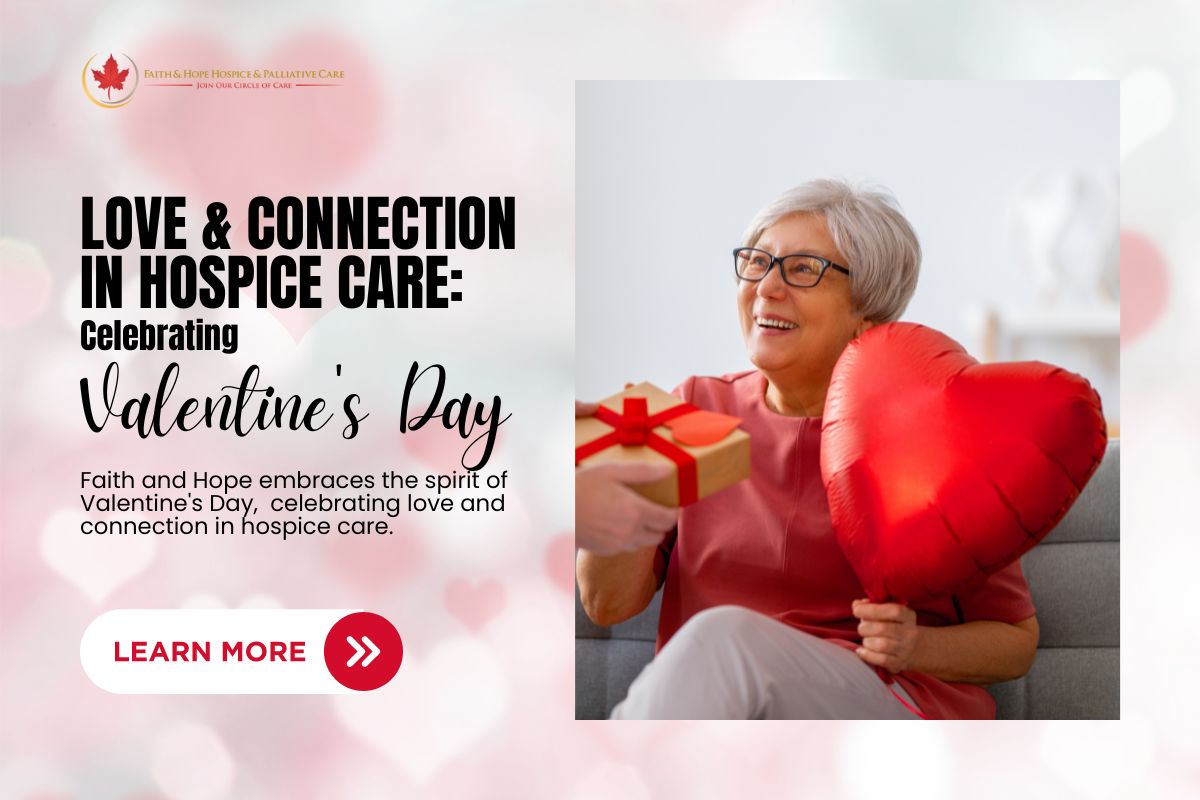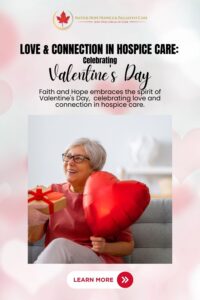
- By: administrator
- Blog
- No Comments
Valentine’s Day is fast approaching, and we at Faith and Hope reflect on the special meaning it holds, especially in the world of hospice care. At Faith and Hope Hospice, serving Los Angeles and nearby Beverly Hills, we understand the importance of love and connection during this unique celebration.
Cultivating Love in Hospice Care:
In Beverly Hills and Los Angeles hospice care, every moment matters, and love plays a powerful role. We know that love can bring comfort and joy, even in times of challenging illnesses. The dedicated team at Faith and Hope Hospice strives to create an environment where love thrives, addressing both the emotional and practical aspects of care.
We at Faith and Hope understand that love goes beyond just a feeling – it’s a powerful force that significantly impacts the well-being and pain management of our patients during their challenging journey.

Love’s Impact on Well-being
In hospice care, love becomes a force, making a real difference in our patient’s lives:
Emotional Strength: Love provides emotional strength, helping patients face life’s challenges with resilience and comfort.
Quality of Life: Love enhances the overall quality of life, creating moments of joy and peace in spite of health complexities or difficulties.
Sense of Purpose: Love contributes to a sense of purpose and belonging, bringing renewed meaning to our patients’ lives.
The Role of Love in Pain Management
In Faith and Hope’s compassionate environment, love plays a crucial role in managing pain for our patients.
Emotional Comfort: Love acts as a soothing balm to our patients, providing emotional comfort that can positively impact the experience of pain and the way they manage it.
Reducing Anxiety: Love diminishes anxiety and fear, creating a relaxed environment that contributes to easing our patients’ pain and suffering.
Enhancing Coping Mechanisms: Love empowers patients with effective coping mechanisms, going beyond medications for a more holistic approach to pain management.
Moments of Connection:
Hospice care in Beverly Hills and Los Angeles is more than just medical support; it’s about creating genuine connections with our care team, our patients, and their families. This month of love allows us to reflect on countless moments where families, patients, and our care team come together to share stories, laughter, and, sometimes, tears. These connections go beyond traditional healthcare, highlighting the human experience and the importance of relationships we share during tough times.
At Faith and Hope Hospice and Palliative Care, we recognize the transformative impact of shared laughter, storytelling, and genuine emotional support. These aspects form the heart of our commitment to creating positive and supportive experiences for our hospice patients.
Shared Laughter and Stories
In hospice care, shared laughter and storytelling are more than moments – they’re therapeutic interventions that elevate our patients’ spirits:
Connecting Through Stories: Storytelling becomes a medium of connection, allowing patients to share their experiences with the team, thus fostering a sense of camaraderie and understanding.
Positive Atmosphere: Shared laughter creates a positive atmosphere, contributing to an environment where patients can find solace and encouragement.
Emotional Support in Tough Times
Going through the often-challenging journey of hospice care, genuine connections form the backbone of emotional support for our patients:
Pillars of Strength: Genuine connections become pillars of strength, providing unwavering support during tough times and offering a shoulder to lean on.
Empathy and Understanding: The emotional support Faith and Hope provides is rooted in empathy and understanding, acknowledging the unique journey of each of our patients and their families.
Companionship: The relationships we built on emotional support bring a sense of companionship to our patients and their families, reminding them that they’re not alone in their challenges.
Family-Centered Care:
At Faith and Hope Hospice, we focus on family-centered care. We understand that the love and support of family members are crucial to a patient’s well-being. Our team collaborates with families, offering not only medical expertise but also emotional support to ensure that love surrounds our patients, providing comfort and upliftment.
Faith and Hope’s commitment goes beyond medical support. We recognize the impact of collaborative decision-making and the emotional resilience of caregivers within the hospice family, creating an environment of unwavering support and love.
Collaborative Decision-Making
In the complex landscape of hospice care, collaborative decision-making emerges as a cornerstone, fostering a supportive and loving environment:
Holistic Involvement: Collaborative decisions involve both the care team and family members, ensuring that the patient’s journey is approached holistically.
Empowering Families: Involving families in decision-making empowers them, providing a sense of control and active participation in the care process.
Enhanced Support System: Collaborative decisions enhance the overall support system, creating a united front that surrounds the patient with love, understanding, and comprehensive care.
Emotional Resilience of Caregivers
Amid the challenges of hospice care, acknowledging and supporting the emotional resilience of caregivers is vital:
Comprehensive Family Support: Faith and Hope Hospice extends its support to family caregivers, recognizing their emotional resilience and providing comprehensive assistance.
Educational Resources: We offer educational resources to caregivers, equipping them with the knowledge and tools necessary to navigate the emotional complexities of caregiving.
Emotional Well-being: The emotional well-being of caregivers is integral to the hospice family’s overall health. Our support aims to uplift and strengthen the emotional resilience of those providing care.
Celebrating Love in Los Angeles:
Los Angeles, with its diverse and vibrant communities such as Beverly Hills, inspires us to celebrate love in all its forms. Whether it’s the love between spouses, the bond of a family, or the connection between our care team and patients, we honor the various expressions of love within our community.
Hospice Near Beverly Hills:
For those looking for hospice care near Beverly Hills, Faith and Hope Hospice is here with compassionate support. Our commitment to fostering love and connection aligns with the spirit of this iconic neighborhood.
Conclusion:
This Valentine’s Day, as we celebrate love and connection, let’s also acknowledge the beauty found in the compassionate care provided by Faith and Hope Hospice in Los Angeles and near Beverly Hills. In the world of hospice, where every day is an opportunity to make a difference, we cherish the moments of love that define our commitment to the well-being of our patients and their families.
